China Society
Chinese Netizens Voice Concerns over Molly the Elephant, Call for Animal Performance Boycott
Molly the elephant has become a powerful symbol for hundreds of other performing elephants in China.
Published
3 years agoon
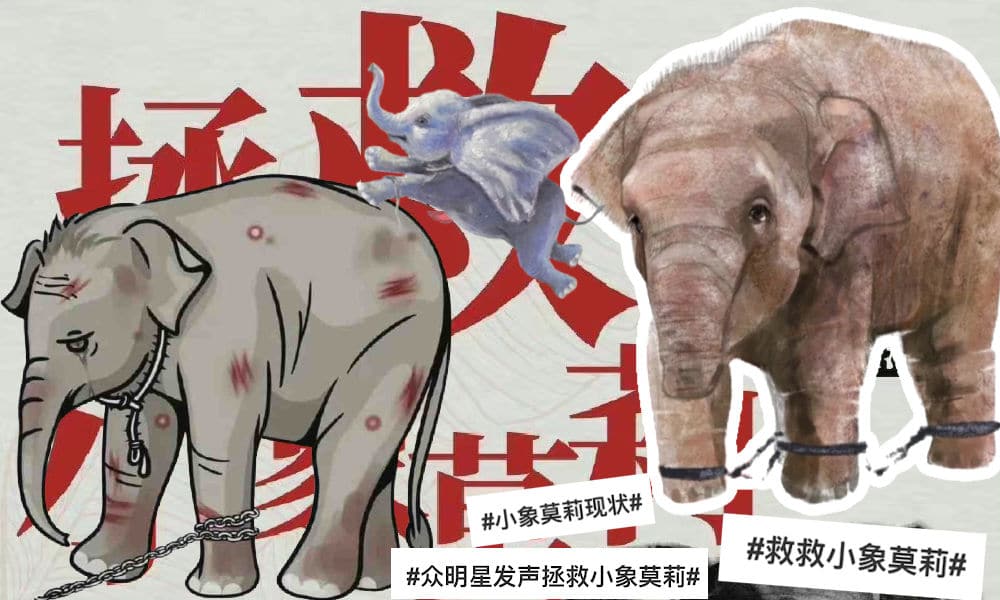
The fate of Molly, an elephant born in the Kunming Zoo and separated from its mother at the age of 2, has become a topic of public debate in China. As viral photos show the elephant being forced to perform tricks, calls for an animal performance ban in China are growing louder.
A little elephant named Molly is a big topic of discussion on Chinese social media this week. There are various hashtags about Molly on Weibo, where the elephant also has several fan forums (‘supertopics’) dedicated to her.
There are Molly artworks, Molly videos, Molly gifs, Molly cartoons, but most of all, there are the calls from netizens to ‘rescue Molly the little elephant’ (#救救小象莫莉#).
Molly’s Chinese name is Mòlì (莫莉), an Asian elephant born on March 20 in 2016 in the Kunming Zoo in Yunnan. The baby elephant was initially nicknamed “Little Princess” (小公主). When she turned one year old, the Kunming Zoo invited the public to help come up with a name for her.
On her first birthday, the popular ‘Little Princess’ received her official name and a special big elephant birthday cake. The celebration was covered by local media at the time.
Although Kunming Zoo initially seemed to take pride in their baby Molly, they separated her from her mother at the age of two in April of 2018. Molly was then transferred from Kunming Zoo to Qinyang, Jiaozuo, in Henan in exchange for another elephant.
Over the past few years, Molly the elephant has allegedly been trained to do tricks and performances and to carry around tourists on her back at the Qinyang Swan Lake Ecological Garden (沁阳天鹅湖生态园), the Qinyang Hesheng Forest Zoo (沁阳和生森林动物园), the Jiaozuo Forestry Zoo (焦作森林动物园), and the Zhoukou Safari Park (周口野生动物世界).
Netizens started raising the alarm about Molly’s welfare when they spotted her chained up and seemingly unhappy, forced to do handstands or play harmonica, with Molly’s handlers using iron hooks to coerce her into performing.
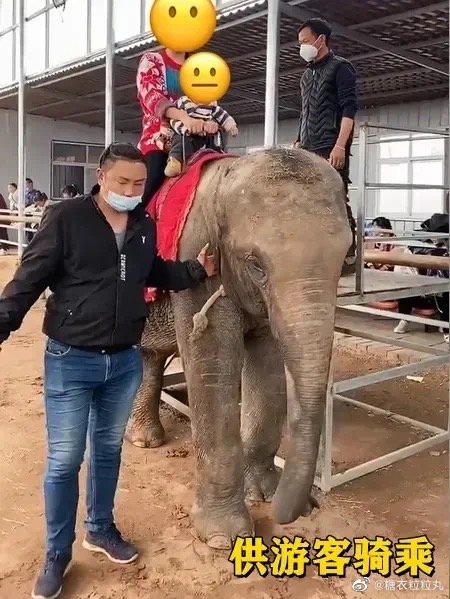

Posts about Molly being abused started to gain more online attention in the summer of 2021, and photos showing the stark difference between Molly at the age of one and at the age of five years old circulated online.
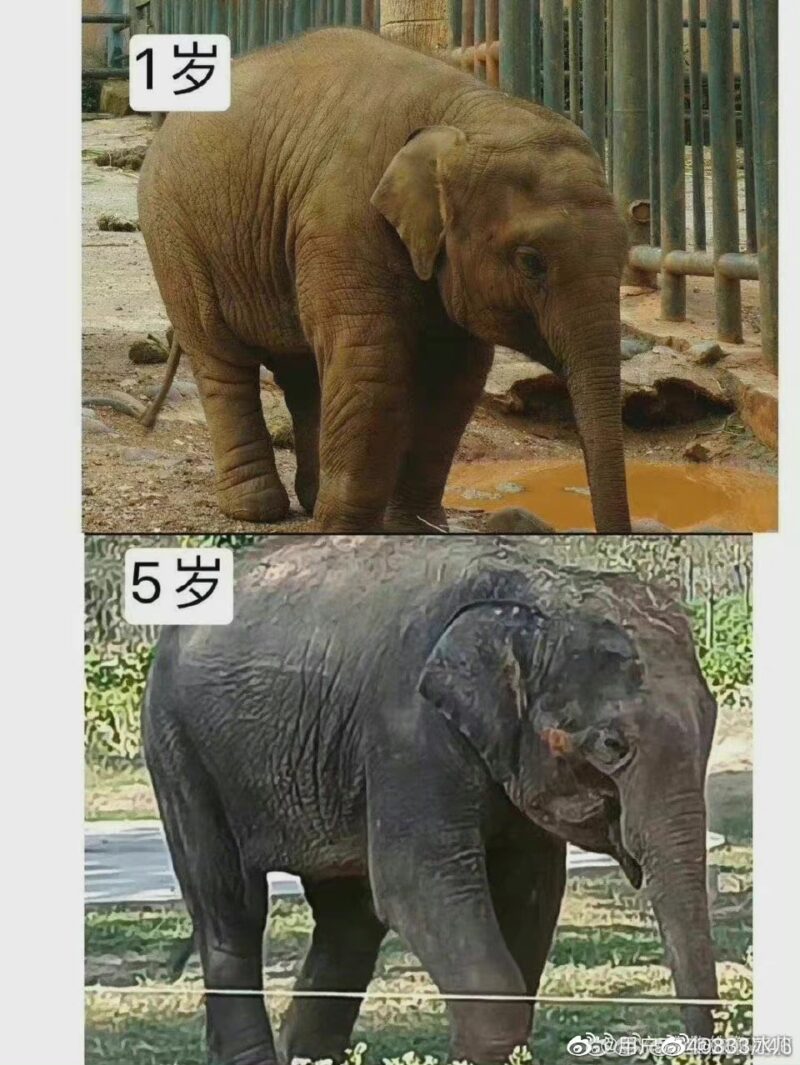
After so many netizens expressed concerns about the elephant’s mistreatment, the local zoo and authorities issued a statement in September of 2021 saying Molly was not being maltreated. But because no further clarification was given, netizens kept pushing for the elephant to be rescued and reunited with its mother in Kunming.
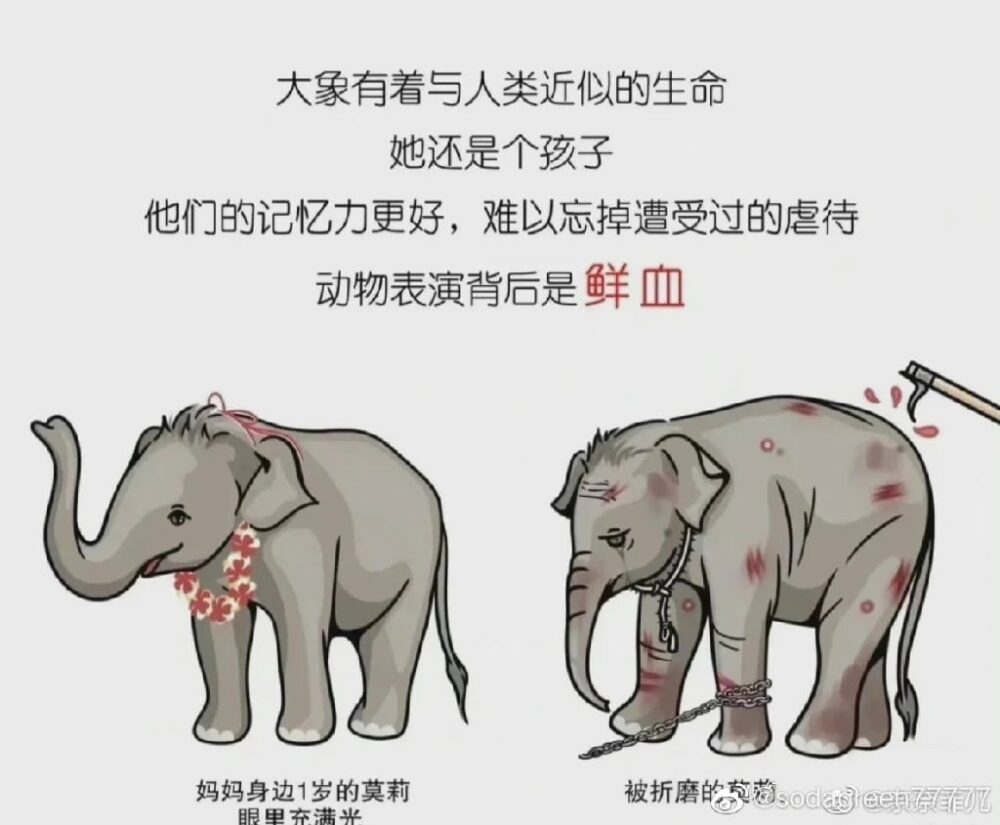
One of the reasons why Molly became a big topic on social media again this week is because her case was pushed forward on the social media platform Xiaohongshu, after which it also gained renewed attention on Weibo due to various big accounts posting about ‘Save Molly’ and calling for an elephant performance ban in China.
One of these influentiual people expressing concerns over the elephant is Taiwanese actress Chen Qiao’en (陈乔恩), who posted about Molly on Weibo on April 24, using the #SaveMollytheElephant hashtag:
“It’s heartbreaking to see Molly covered in wounds. She shouldn’t be treated like this. Please reject animal performances, please don’t abuse animals, please save Molly the elephant.”
Chen’s post received over 90,000 likes and a lot of attention, leading to more netizens voicing their concerns about the elephant and joining online groups about Molly’s case.
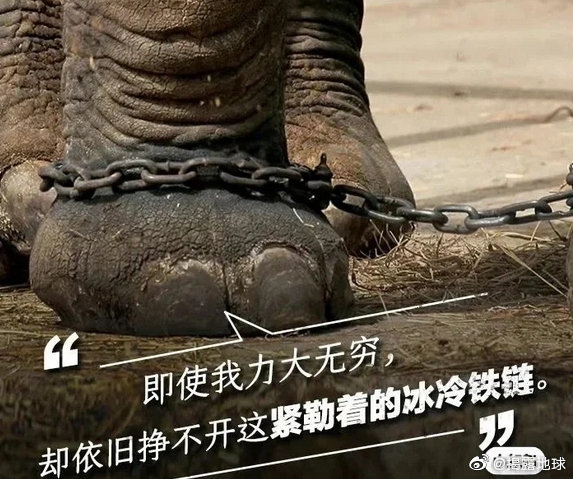
As voices speaking up for Molly grew louder, some of the groups and hashtags related to the ‘Save Molly’ movement were taken offline by Weibo censors.
“There are many ‘Molly’s’ in this world, the more you try to silence us, the louder we will get,” one Weibo commenter wrote.
A Maze of Conflicting Regulations
Beyond Molly’s situation, there is a somewhat confusing web of laws, regulations, and standards about wildlife protection and animal performances in China.
China’s Wildlife Protection Law (WPL), the national legislation for animal protection, was enacted in 1989. Throughout the decades, the law was widely criticized for not doing enough to actually protect animals and promoting the use of wildlife for human benefit. Although the law was revised in 2015, it still facilitated the commercial use of wildlife and there is no anti-cruelty legislation that might penalize cruelty to animals in zoos, wildlife parks, or other venues where wild animals are kept in captivity (Li 2021, p. 227).
When it comes to China’s zoos and safari parks, there are two regulatory bodies that play an important role: China’s Ministry of Housing and Urban-Rural Development (住房城乡建设部, MHURD), and the Chinese State Forestry and Grassland Administration (国家林业和草原局, SFGA).
The Ministry of Housing and Urban-Rural Development (MHURD) is the relevant organ overseeing Chinese zoos, which are usually owned and managed by municipal or regional governments. The MHURD also hosts the Chinese Association of Zoological Gardens (中国动物园协会, CAZG), which is an organization that most of China’s larger zoos are members of.
China’s Ministry of Housing and Urban-Rural Development banned animal performances in China over a decade ago in 2011, although the rule excluded performances at aquariums and did not specify penalties (China Daily 2012). In 2013, the MHURD also issued the “National Zoo Development Outline” (“全国动物园发展纲要“) which strictly prohibited all animal performances in zoos.
Nevertheless, many zoos and wildlife parks have still continued shows featuring cycling bears, jumping tigers, and dancing elephants since then – and not necessarily illegally.
One of the reasons why there are conflicting regulatory regimes is because “zoos” and “wild animal parks” fall under different jurisdictions in China.
The MHURD 2011 administrative national ban on animal performance was unable to stop animal performances at China’s privately-owned wild animal parks, safari parks, or circuses, since they are administered by the Chinese State Forestry and Grassland Administration (SFGA), which also regulates the holding of all exotic species, including those in city zoos. The SFGA, however, does not consider the welfare of these animals its responsibility (see Arcus Foundation 2021, p. 99; Li 2021, p. 227).
City zoos can theoretically still subcontract animal performances to private companies within special areas of the zoo as long as their contract was signed before 2011, and can also still sell or trade animals with these parks. Dozens of zoos with performance programs have therefore continued animal performances, sometimes also in violation of policies in place (Arcus Foundation 2021, p. 99; Li 2021, p. 19).
In line with the WPL, the SFGA is able to provide permits that allow animal parks to hold animal “exhibition and performances.” The Qinyang Swan Lake Ecological Garden, where Molly is, also has a permit to “showcase wildlife” (展演野生动物), basically giving them a green light to put on performances.
Beyond Molly
On April 27, the Kunming Zoo responded to the online storm over Molly, claiming that the elephant is in good condition and that the zoo in question has since long stopped animal performances.
Chinese media outlet Phoenix News also published an article about Molly on April 30, aimed to uncover the truth about the conditions in which Molly is currently being kept at the Qinyang Hesheng Forest Zoo.
The report concluded that Molly was kept in good living conditions, and that the elephants at the park were not participating in any (circus) performances. The person in charge of the Qinyang Hesheng Forest Zoo, Shi Baodong (史保东) reportedly claims the park has stopped all animal performance activities as of April 2019, with Shi denying all claims of animal abuse taking place.
Staff members also said that some of the footage and images circulating online in relation to the Molly incident are not of Molly at all, instead showing elephant training in Thailand, India and other countries.
But many Chinese netizens believe the zoo is not speaking the truth, since social media users said they still saw Molly performing and carrying zoo visitors on her back in 2021. Even if Molly is not performing at this moment, many still think that media reports and statements cover up the truth of how the elephant is really doing.
For others, the ‘Save Molly’ hashtag is not just about Molly anymore, as the elephant has come to represent hundreds of other elephants who are living in captivity in China and are forced to perform. They hope the government can prohibit elephant performances entirely and introduce better laws and regulations to prohibit animal performances and mistreatment.
“One person doesn’t have a lot of power, but as a group we have more power,” the description for one Molly supertopic on Weibo says (小吉象莫莉).
Underneath one of the Weibo threads about Molly’s current situation, a top commenter replies: “This is not just about Molly anymore, we want to protect all of the ‘Molly’s’ out there.”
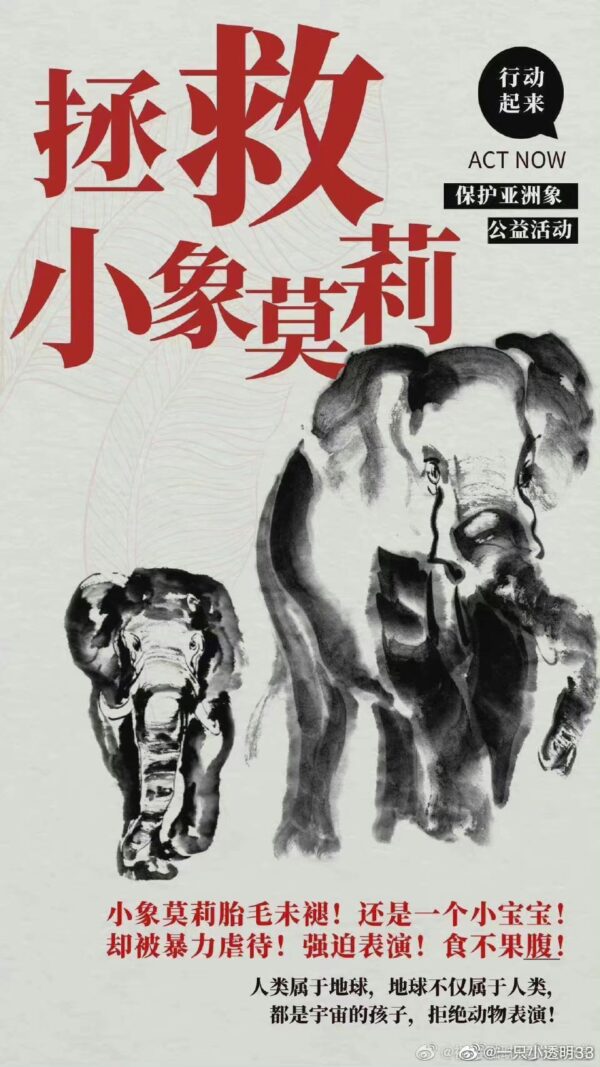
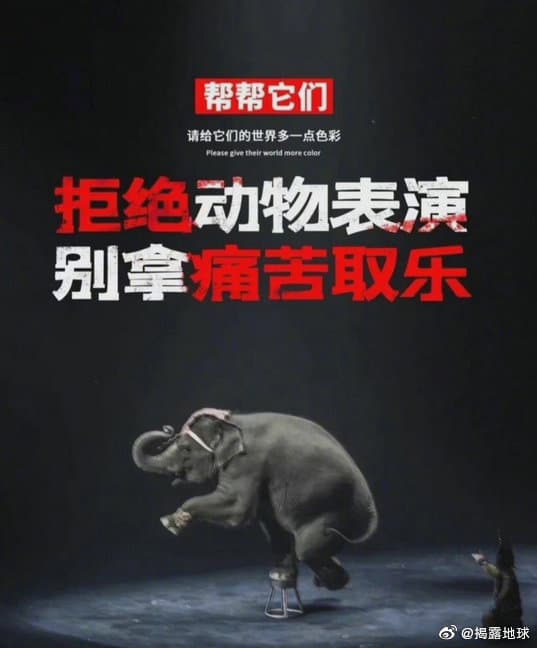
“Reject animal performances, don’t turn suffering into entertainment.”
This is not the first time netizens come into action to get justice for zoo animals that are suffering. In 2017, visitor photos of a mouth-foaming, lethargic-looking panda at Lanzhou Zoo also caused outrage on Weibo. In 2016, netizens also jumped to the aid of a polar bear by the name of Pizza after he was found living in deplorable conditions at an aquarium in the Grandview Mall in Guangzhou. He was later removed from the mall.
UPDATE MAY 17 2022: MOLLY RETURNS TO KUNMING ZOO
To follow more updates regarding Molly, check out Twitter user ‘Diving Paddler’ here. We thank them for their contributions to this article.
To read more about zoos and wildlife parks causing online commotion in China, check our articles here.
By Manya Koetse
References (other sources linked to within text)
Arcus Foundation (Ed.). 2021. State of the Apes: Killing, Capture, Trade and Ape Conservation. Cambridge: Cambridge University Press.
China Daily. 2012. “Animal Rights Groups Seek Performance Ban.” China Daily, April 16 http://www.china.org.cn/environment/2012-04/16/content_25152066.htm [Accessed May 1 2022].
Li, Peter J. 2021. Animal Welfare in China: Culture, Politics and Crisis. Sydney: Sydney University Press.
Get the story behind the hashtag. Subscribe to What’s on Weibo here to receive our weekly newsletter and get access to our latest articles:
Spotted a mistake or want to add something? Please let us know in comments below or email us. First-time commenters, please be patient – we will have to manually approve your comment before it appears.
©2022 Whatsonweibo. All rights reserved. Do not reproduce our content without permission – you can contact us at info@whatsonweibo.com.
Manya is the founder and editor-in-chief of What's on Weibo, offering independent analysis of social trends, online media, and digital culture in China for over a decade. Subscribe to gain access to content, including the Weibo Watch newsletter, which provides deeper insights into the China trends that matter. More about Manya at manyakoetse.com or follow on X.
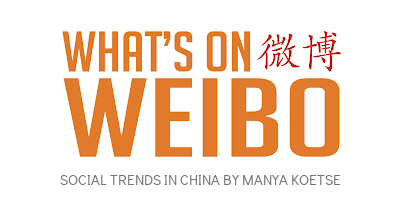
You may like
China Society
The Rising Online Movement for Smoke-Free Public Spaces in China
From foreign anti-smoking bloggers to the “Modern Lin Zexu,” China is seeing a rise in online anti-smoking activism.
Published
7 days agoon
August 14, 2025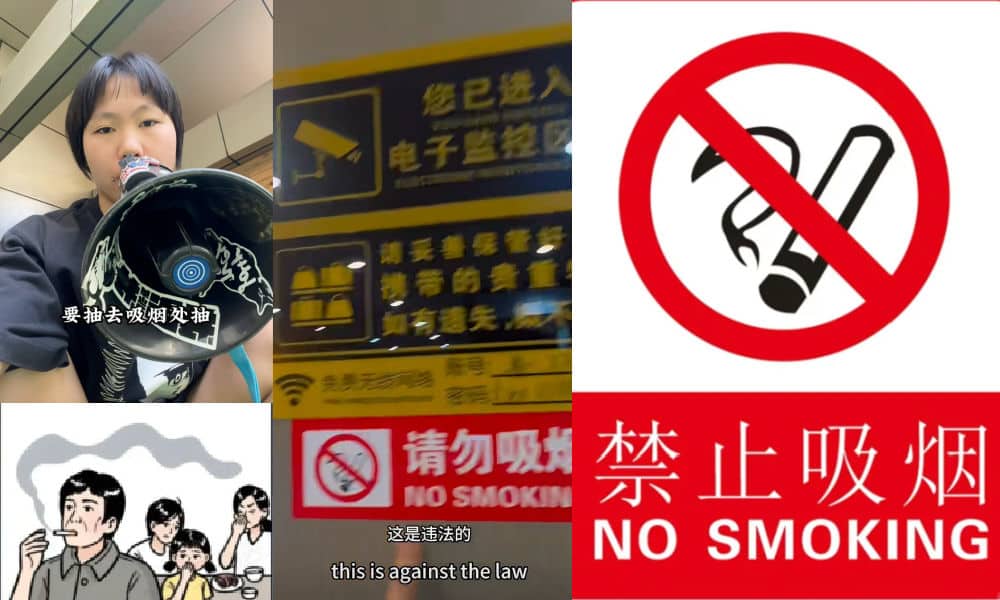
Anti-smoking activism, especially by foreigners, has recently drawn attention on Chinese social media. A renewed online push to stop smoking in no-smoking areas highlights broader challenges of enforcing public smoking bans in a country where smoking remains prevalent.
From “smoking is prohibited in public spaces” (#公共场所禁止吸烟#) to “tobacco control” (#控烟#), anti-smoking hashtags have been popping up more frequently on Chinese social media. Many of them accompany videos from influencers who call out or try to stop people smoking where it’s not allowed.
Some of these influencers aren’t even Chinese.
In recent years, Chinese media reports and online discussions have fueled a perception among many netizens that foreigners in China often receive preferential treatment. In certain situations, this perception seems to hold true — perhaps linked to a belief among some officials that incidents involving foreigners are diplomatically sensitive and tied to China’s image. This can lead to extra caution or leniency in handling such cases, sometimes giving foreigners an unspoken advantage in public-facing services and spaces, from dormitories to restaurants.
Now, some netizens are suggesting that foreign residents use this “advantage” to report public smoking violations more actively.

A post on RedNote saying, “I hope every foreigner traveling to China will help complain about the problem of smoking in public spaces in China,” received many likes and thousands of comments.
Others even suggest that foreigners could quickly build their social media followings by posting such encounters, dubbing them “anti-smoking bloggers” or “smoking-dissuasion bloggers” (劝烟博主).
Foreign Influencers’ Anti-Smoking Efforts Go Viral
One of these anti-smoking foreign bloggers is Xiaohongshu blogger “Alibabame” (alibabame 艾伦, real name Malik X.). On July 30, he posted a video in which he asked two Chinese men to stop smoking in a restaurant with a prominent “No Smoking” sign, speaking mostly in English with some Mandarin phrases.
The exchange turned tense and turned into a verbal altercation, but the clip went viral — by 11 PM on August 1, it had attracted over 154,000 likes and 18,000 comments, his highest engagement rate to date according to Newrank data. His other most-viewed posts have also centered on smoking dissuasion.

Many of Alibabame’s videos focus on discouraging smoking in public.
In a follow-up video shared on August 1, Alibabame said local police had given him a surprising interpretation of the rules: if someone smokes in a no-smoking area but extinguishes the cigarette after being asked, they are not breaking the law. Many viewers expressed disbelief, with comment sections filled with criticism and calls for stricter enforcement.
From Online Clashes to Court Cases
These recent viral clips have turned a niche activist effort into a broader discussion about how China’s anti-smoking regulations are interpreted — and whether enforcement can match public expectations.
Shanghai, for instance, has comprehensive smoking control rules Indoor public venues, workplaces, and public transport — including e-cigarettes — are fully smoke-free, with individuals facing fines of 50–200 yuan (US$7-US$28) and establishments up to 30,000 yuan (US$4180) for failing to prevent smoking. Outdoor bans cover spaces for children and teenagers, medical facilities, sports and performance venues, heritage sites, and transit stops.
Violations can be reported via the Public Service Hotline 12345 or other hotlines.
Earlier this year, Shanghai also became the first mainland city to target “wandering smoking (游烟)” control measures, banning smoking while walking in outdoor queues, sidewalks, and at popular spots such as the Bund and Wukang Road. Offenders face fines of up to 200 yuan ($28).
Despite these measures, ensuring smoke-free environments remains a problem in Shanghai and across other mainland cities.
Recent high-profile cases illustrate the difficulties. On July 3, Renwu magazine (人物) published an article titled “The ‘Lin Zexu of Universities’ and the War Against Secondhand Smoke” (“高校“林则徐”与二手烟的战争“), profiling Shang Mengmeng (尚萌萌), a Beijing film school graduate student with extreme nicotine sensitivity. After leaving jobs due to smoke exposure, he hoped campus life would be different, only to encounter smoking indoors, even in elevators and classrooms. Since March, Shang has filed about 120 complaints using cigarette butts and ash as evidence, earning him the nickname “Modern Lin Zexu” — referencing the Qing Dynasty official famed for his anti-opium stance.
Supporters praise his persistence, but Shang has also faced backlash from smokers accusing him of “extremism,” and even some non-smokers questioning his approach. Shang maintains he is not against smoking itself, only against smoking in prohibited areas, framing it as a matter of personal freedom versus public health rights.

On June 28, 2025, the Shenzhen Health Commission published an article titled “Secondhand Smoke Is Actually a Form of Bullying” (Image: Shenzhen Health Commission WeChat account).
Another case, reported by Southern People Weekly (南方人物周刊) on July 27, follows Jin Lanlan (金烂烂), a young woman assaulted in a mall after asking a man to stop smoking. On November 11, 2024, Jin confronted Tang, who responded with verbal abuse and a kick. Police fined Tang 200 yuan ($28), but he refused to apologize or compensate, prompting Jin to sue.
At a July 22 court hearing, Tang’s lawyer rejected all demands. Jin, who experienced secondhand smoke-induced vomiting as a child and left art school due to teachers smoking indoors, sees her actions as defending her legal rights. While some hail her as a “fighter,” others — including her own mother, who speaks of her “making trouble” — question her persistence.
The Road Ahead for Smoking Control in China
These court cases, along with the online discussions around the videos of foreign influencer ‘Alibabame,’ reveal long-standing obstacles to public smoking control on the mainland.
➤ Generational divides play a role: younger people are generally more aware of secondhand smoke risks, while some older smokers see it as a personal choice. Smoking also remains embedded in social customs, such as offering cigarettes at business or family gatherings.
➤ Misunderstandings about “freedom” and “rights” compound the problem, with some smokers prioritizing personal choice over non-smokers’ health rights, and many non-smokers staying silent to avoid further conflict.
➤ Enforcement is another weak point. Responsibility is split among multiple agencies, creating gaps in oversight. In smaller cities and rural areas, limited resources make it harder to police high-risk venues like restaurants and internet cafés. Low fines — as little as 50 yuan (US$7) in some places — do little to deter violations.
Hong Kong, Macau, and Taiwan provide contrasting examples, with much higher on-the-spot fines — HKD1,500 (US$190), MOP1,500 (US$186), and NTD2,000–10,000 (US$62–310) respectively — and dedicated enforcement bodies such as Hong Kong’s Tobacco and Alcohol Control Office.
As more mainland residents speak out, calls for stricter enforcement are growing. Some netizens have even urged Alibabame to involve international media like The New York Times to pressure authorities, but he has declined, stressing that this is a domestic issue and expressing confidence that Chinese authorities will act.
Whether this wave of public attention will push Shanghai toward tougher enforcement, and whether similar measures could spread to other mainland cities, remains uncertain.
What is certain is that smoking control will be a long-term challenge in China, requiring stronger enforcement, higher penalties, and, perhaps most crucially, a cultural shift that prioritizes clean air for non-smokers as much as the “freedom” of smokers.
Meanwhile, Alibabame’s follower count is climbing — he gained over 79,200 new followers since his viral video. His popularity suggests growing online support for smoking-dissuasion influencers, both foreign and Chinese, who are taking a stand for smoke-free public spaces.
Also Read:
- Zhang Yue, “China’s First Anti-Smoking Campaigner” (“中国第一反烟人”)
- Social Media Blows Up over Chinese Teen Celebrity Roy Wang Smoking in Beijing Restaurant
By Wendy Huang
Edited by Manya Koetse
Spotted a mistake or want to add something? Please let us know in comments below or email us. Please note that your comment below will need to be manually approved if you’re a first-time poster here.
©2025 Whatsonweibo. All rights reserved. Do not reproduce our content without permission – you can contact us at
info@whatsonweibo.com
China Insight
“Jiangyou Bullying Incident”: From Online Outrage to Offline Protest
“You think we’re scared of you? It’s not like we haven’t been to jail before.”
Published
2 weeks agoon
August 6, 2025
These days have been filled with tension and anger in the city of Jiangyou (江油市), Sichuan, after a rare, large-scale protest broke out following public outrage over a severe bullying incident and how it was handled.
The bullying incident at the center of this story happened outside school premises in Mianyang on the afternoon of July 22. Footage of the assault, recorded by bystanders at the scene, began circulating widely online on August 2, sparking widespread outrage among concerned netizens, many of them worried parents.
The violent altercation involved three girls between the ages of 13 and 15 who ganged up on another minor, a 14-year-old girl named Lai (赖).
After Lai and a 15-year-old girl named Liu (刘) reportedly had a dispute, Liu gathered two of her friends—the 13-year-old also named Liu (刘) and a 14-year-old named Peng (彭)—to gang up on Lai.
The three underage girls lured Lai to an abandoned building, where they subjected her to hours of verbal and physical violence. The footage showed how they took turns in kicking, slapping, and pushing her.
At one point, after Lai said she would call the police, one of the bullies yelled: “You think we’re scared of you? It’s not like we haven’t been to jail before. I’ve been in more than ten times—it doesn’t even take 20 minutes to get out” (“你以为我们会怕你吗?又不是没进去过,我都进去十多次了,没二十分钟就出来了”).
That same night, the incident was reported to police. It took authorities until August 2 to bring in all involved parties for questioning, and a police report was issued on the morning of Monday, August 4.
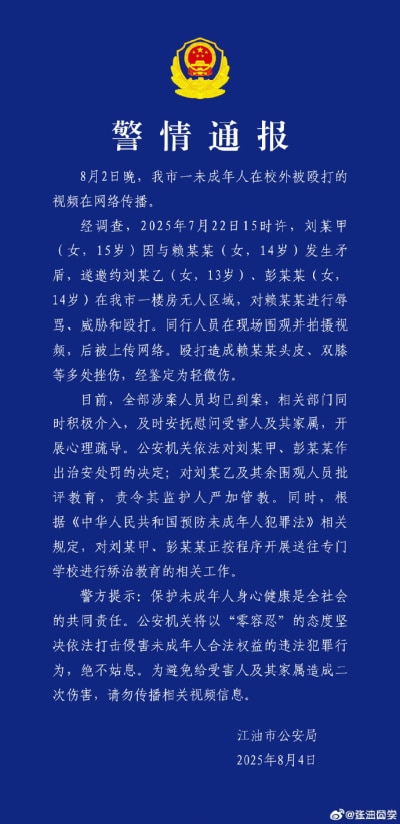
Police report by Jiangyou Public Security Bureau, confirming the details of the incident and the (legal) consequences for the attackers.
Two of the girls (the 15- and 14-year-old) were given administrative penalties and will be sent to a specialized correctional school. The younger Liu and other bystanders were formally reprimanded.
“Parents Speak Out for the Bullied Girl”
The way the incident was handled—not just the relatively late official report, but mostly the perceived lenient punishment—triggered anger online.
Many people who had seen the video responded emotionally and felt that the underage girls should be stripped of their rights to take their exams, and that the bullying incident should forever haunt them in the same way it will undoubtedly haunt their victim.
Especially the phrase “It’s not like I haven’t been taken in [to jail] before” struck a chord, as it showed just how calculated the bullies were—and how, by counting on the leniency of the Chinese judicial system for minors, they made the system complicit in their determination to turn those hours into a living hell for Lai.
China has been dealing with an epidemic of school violence for years. In 2016, Chinese netizens were already urging authorities to address the problem of extreme bullying in schools, partly because minors under the age of 16 rarely face criminal punishment for their actions.
Since 2021, children between the ages of 12 and 14 can be held criminally responsible for extreme and cruel cases resulting in death or disability—but their legal prosecution must first be approved by the Supreme People’s Procuratorate (SPP).
It has not done much to stop the violence.
Discussions around extreme bullying like this have repeatedly flared up over the years, such as in 2020, when a 15-year-old schoolboy named Yuan (袁) in Shaanxi was fatally beaten and buried by a group of minors.
Last year, a young boy named Wang Ziyao (王子耀) was killed by three classmates after suffering years of bullying. His body was found in a greenhouse just 100 meters from the home of one of the suspects, and the case shocked and enraged local residents.
But the problem is widespread among girls, too.
In 2016, we already reported on how so-called ‘campus violence videos’ (校园暴力视频) had become a concerning trend. In these kinds of videos—often showing multiple bullies beating up a single victim on camera—it’s not uncommon to see girls as the aggressors.
Girls often form cliques to gang up on a victim to show that they are in control or to gain popularity. They also tend to be more inclined than boys to make cruel jokes or stage pranks meant to embarrass or humiliate their target. This may partly explain why there seem to be more campus violence videos on Chinese social media showing girls bullying girls than boys bullying boys.
In the case of Lai, she appears to have been particularly vulnerable. One of her relatives posted online that her mother is deaf and mute, and her father allegedly is disabled. This fact may have contributed to why Lai was repeatedly targeted and bullied by the same group of girls, who reportedly took away her phone and socially isolated her at school.
In response to the incident, netizens started posting the hashtag “Parents Speak Up for the Bullied Girl” (“#家长们为被霸凌女孩发声#), not only to support Lai and her family, but to demand harsher punishments for school bullies and for stricter crackdown on this nationwide problem.
From Online Anger to Offline Protest
While many people spoke out for Lai online, hundreds also wanted to show up for her in person.
On August 4, dozens of people gathered in front of the Jiangyou Municipal Government building (江油市人民政府) to demand justice and support Lai’s parents, who had come to express their grievances to the authorities—at one point even bowing to the ground in a plea for justice to be served for their daughter.

Footage and images circulating on social media showing the parents of Lai, the victim, bowing on the ground to demand justice from authorities.
As the crowd grew larger, tensions escalated, eventually leading to clashes between protesters and police.
The arrests at the scene did little to ease the situation. As night fell, the mood grew increasingly grim, and some protesters began throwing objects at the police.

Images of the protest, posted on Weibo.
Near the east section of Shixian Road (诗仙路东段), more people gathered. Hundreds of individuals filming and livestreaming captured footage of the police crackdown—officers beating protesters, dragging them away, and deploying pepper spray.

Netizens’ digital artwork about the bullying incident, the parents’ grievances, and the public protest and its crackdown in Jiangyou. Shared by 程Clarence.
Although the protests briefly gained traction on social media and became a trending topic on Weibo, the search term was soon removed from the platform’s trending list.
Lasting Mental Scars
On Tuesday, August 5, several topics related to the Jiangyou bullying incident began trending again on Chinese social media.
On the short video app Kuaishou, a collective demand for justice surged to the number one spot, under the tag “A large number of Jiangyou parents demand justice for the victim” (江油大批家长为受害学生讨公道).
As of now, none of the perpetrators’ families have come forward to apologize.
As for Lai—according to the latest reports, she did not suffer serious physical injuries from the bullying incident, but according to her own parents, the mental scars will last. She will need continued mental health support and counseling going forward.
Although many posts about the incident and the ensuing protests have been taken offline, ‘Jiangyou’s Bullying Incident’ has already become one more case in the growing list of brutal school bullying incidents that have surfaced on Chinese social media in recent years. The heat of local anger may fade over time, but the rising number of such cases continues to fuel public frustration nationwide—especially if local authorities fail to do more to address and prevent school bullying.
“Not being able to protect our children, that’s a disgrace to our schools and the police,” one commenter wrote: “I want to thank all those mothers who have raised their voices for the bullied child. Each of us must say no to bullies, and we must do all we can to stop them. I hope the lawmakers agree.”
By Manya Koetse
(follow on X, LinkedIn, or Instagram)
Spotted a mistake or want to add something? Please let us know in comments below or email us. First-time commenters, please be patient – we will have to manually approve your comment before it appears.
©2025 Whatsonweibo. All rights reserved. Do not reproduce our content without permission – you can contact us at info@whatsonweibo.com.
Subscribe
What’s on Weibo is a reader-supported publication, run by Manya Koetse (@manyapan), offering independent analysis of social trends in China for over a decade. To receive new posts and support our work, consider becoming a paid subscriber.


Passing the Torch from ‘Ne Zha’ to ‘Nobody’: China’s Box Office Poster Relay Tradition

The Rising Online Movement for Smoke-Free Public Spaces in China

China Trend Watch: Deadly Nanchang Stabbing, Animation Hit ‘Nobody’ & Diplomatic Rift over Dalai Lama

China Trend Watch: Pagoda Fruit Backlash, Tiananmen Parade Drill & Alipay Outage (Aug 11–12)

“Jiangyou Bullying Incident”: From Online Outrage to Offline Protest

Hidden Cameras and Taboo Topics: The Many Layers of the “Nanjing Sister Hong” Scandal

Inside the Labubu Craze and the Globalization of Chinese Designer Toys

“Jiangyou Bullying Incident”: From Online Outrage to Offline Protest

The Next Labubu: What the Rise of Wakuku Tells Us About China’s Collectible Toy Wave

A Very Short Guide to China’s Most Popular Designer Toys

Earring Gate: Huang Yangdiantian and the 2.3 Million RMB Emerald Earrings

Yearnings, Dreamcore, and the Rise of AI Nostalgia in China

10 Viral Chinese Phrases You Didn’t Know Came From Video Games

Lured with “Free Trip”: 8 Taiwanese Tourists Trafficked to Myanmar Scam Centers

Beauty Influencer Du Meizhu Accused of Scamming Fan Out of $27K
Get in touch
Would you like to become a contributor, or do you have any tips or suggestions? Get in touch here!
Popular Reads
-

 China Memes & Viral1 month ago
China Memes & Viral1 month agoHidden Cameras and Taboo Topics: The Many Layers of the “Nanjing Sister Hong” Scandal
-

 China Books & Literature10 months ago
China Books & Literature10 months agoThe Price of Writing Smut: Inside China’s Crackdown on Erotic Fiction
-

 China Society11 months ago
China Society11 months agoDeath of Chinese Female Motorcycle Influencer ‘Shigao ProMax’ Sparks Debate on Risky Rides for Online Attention
-

 China Insight4 months ago
China Insight4 months agoUnderstanding the Dr. Xiao Medical Scandal



